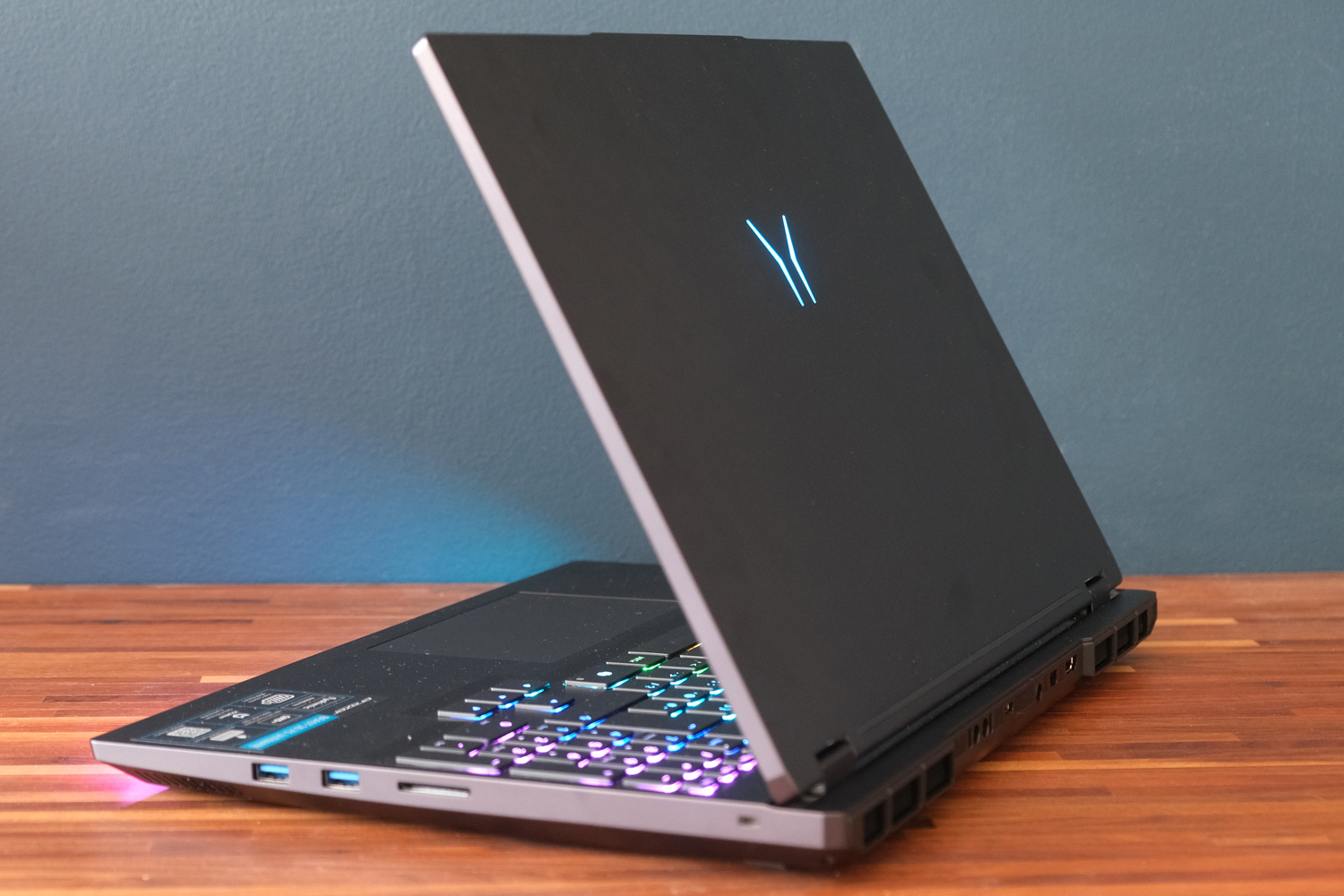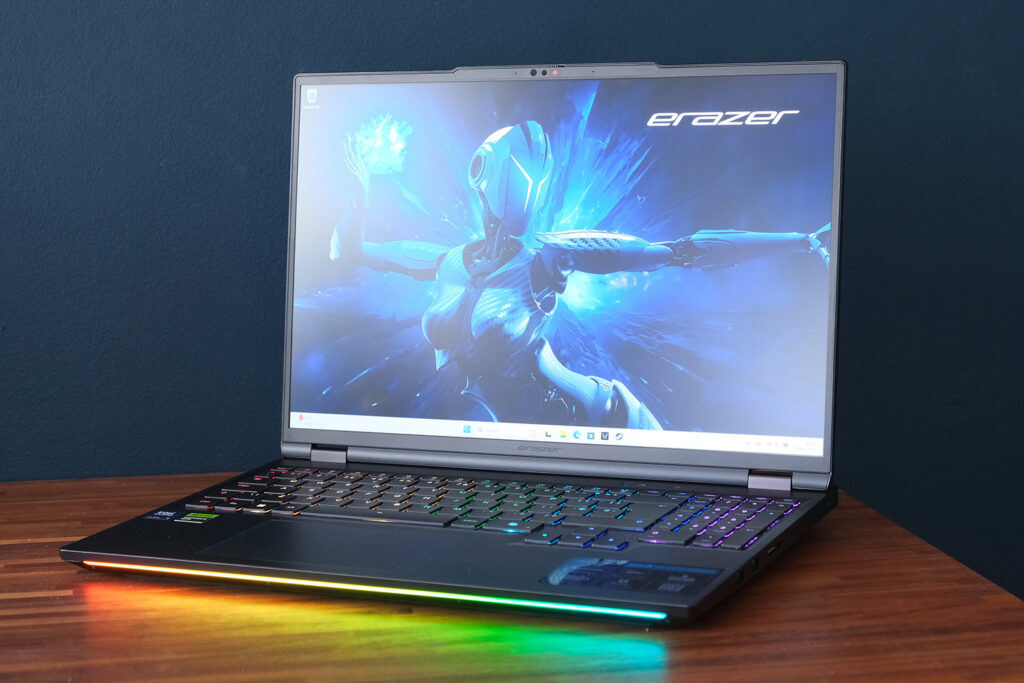Introduction
Laptop gaming can feel like a rich person’s pursuit right now. The latest Nvidia mobile graphics cards might boast fabulous frame rates, but they also demand mortgage payment-level prices – especially if you’re after one of the top-tier versions. The Erazer Beast 16 X1 could be an exception to that rule; at the time of writing, Medion’s 16in machine is the most affordable way into RTX 5080 ownership.
Now I’m in no way saying £2500 (roughly $3400, although Medion kit isn’t easy to come by in the US) is a bargain, but the brand has come a long way from the days of being a supermarket special. The Beast 16 X1 is a heck of a lot of hardware for your cash, with an esports-grade refresh rate, massive amounts of SSD storage, and a proper powerhouse of an Intel CPU.
That could put it into contention with the best gaming laptops from more well-known brands. The similarly priced Acer Predator Helios Neo 16 AI makes do with a more mid-range GPU, half the storage, and a slower refresh rate screen; an MSI Stealth A18 AI+ also gets 5070 Ti power, yet costs more. Does that make the Medion something of a value champ?
Design & build: stealthy gamer

The Erazer Beast 16 X1 isn’t a scratch-build of the sort you’d get from Asus or Razer; Medion has instead taken an off-the-shelf chassis and added a few bespoke tweaks, like the subtle logo on the lid. The all-metal construction is still pretty slick (if a little too keen to highlight fingerprint smudges) and while I wouldn’t call it especially slim, the tapered shape means dimensions have mostly been kept in check.
That includes the protruding section at the rear. These have quickly become the norm for gaming laptops, as they leave plenty of room for cooling. It only pokes out a small way here, so I was able to slide the Erazer into my rucksack without any issues. The colour-changing LED light strip at the front edge then really hammers home this laptop’s intended purpose.
Bumping the power, HDMI and mini DP ports to the rear help keep cables out of sight when sat at a desk. There’s also a USB 4 Type-C port, so you’re not short on options for hooking up an external display. The two extra holes to the side are for Medion’s external water cooling kit – though at the time of writing it only seemed to be on sale in Germany, for a considerable €250.
Connectivity is decent at the sides, too, with a full-size SD card reader and two USB-A ports on the right, and one USB-C, one USB-A, a 3.5mm headphone port and an Ethernet input on the left. You’ll appreciate that last one if the thought of playing games over a spotty Wi-Fi connection sends shivers down your spine. You won’t find a fingerprint sensor, but the webcam supports Windows Hello facial recognition. Its integrated privacy shutter is a nice touch.
At 2.67kg this is no lightweight, and you’ll also have to factor in the substantial power brick when packing up to play away from home. The skinniest gaming laptops do admittedly come at a premium, however, and this is far from desktop replacement territory. Unless you’re wanting a machine to travel with on the daily, this is still perfectly portable.
Keyboard & touchpad: just my type
You don’t get a gaming-grade mechanical keyboard inside the Erazer Beast 16 X1 – but it gets surprisingly close to replicating the feel of one. Each key has a decent amount of travel and a wonderfully springy action. It even sounds satisfying to rattle away at, so long as you aren’t constantly bottoming out with every press. Heavy-handed typists take note.
There’s per-key RGB backlighting, of course -because what self-respecting gaming laptop would go without? Coverage is excellent, really flooding each key with light, and brightness is ample. You can configure it through Medion’s software, but the options are more pared-back from what you’ll see on rival machines.
The mostly full-size QWERTY layout is comfortably spaced out, too, despite having to squeeze up a bit for a half-size numerical keypad. Personally I can live without these on 16in and smaller laptops, as the numbers just feel a little too cramped; I’d rather reach for an external keyboard for any major number crunching. But I get that others will appreciate it being there for when you’re working on the go.
You won’t find any macro buttons, just a row of half-height function keys that double as multimedia shortcuts. I like that the power button sits above the keyboard tray, so you’re not likely to hit it accidentally while dancing your fingers over the board mid-multiplayer match. The button next to it toggles through the various performance modes.
The touchpad sits slightly off-centre from the screen, but is perfectly placed beneath the middle of the keyboard. It’s a respectable size, smooth to slide your finger over, and has a firm mechanical click. Haptic touchpads are becoming more common on high-end gaming laptops, but I didn’t miss one here. Most gamers are going to reach straight for a mouse to play anyway.
Screen & sound: delivers the goods
By giving the Erazer a 2560×1600 resolution screen, Medion hasn’t asked too much of the laptop’s graphics card while gaming – and hasn’t really lost much in terms of visible sharpness or detail compared to a 4K panel when squeezed across 16in. Everything from games to the Windows desktop looked crisp and clear. Viewing angles are really rather good, too, with a huge 180-degrees of screen tilt meaning I didn’t have to try hard to find a sweet spot.
Using a mini-LED panel gives this laptop a real advantage over IPS rivals in terms of black levels and contrast. Light bloom and leak are well controlled, with even starry night sky scenes (the bane of mini-LED) avoiding much in the way of halo effects. It gets impressively bright, so much so I needed to stick to 50% when gaming at night, and the matte panel finish helps diffuse distracting light reflections without making the image appear too grainy.
Would I pay extra for a laptop with an OLED screen? Maybe, if colour coverage and accuracy were mission critical – although both are hardly lacking here. OLED also wins out for response times, but the Erazer’s 240Hz refresh rate lets it get close enough to compete.
The six speaker array hidden beneath the Erazer’s metal shell is a great match to the screen. Four 2W tweeters and two 2W woofers get satisfyingly loud and aren’t too stingy when it comes to bass. I still defaulted to a headset when playing games, as they can’t match one for positional audio – but they get the job done for video streaming.
Performance: Maxed out for most people
That the Erazer Beast 16 X1 is a desktop powerhouse shouldn’t really come as a surprise; what laptop costing four figures isn’t? It helps that the Intel Core Ultra 9 275HX processor has a whopping 24 cores (8 performance cores and 16 efficiency cores), and is pared with 32GB of DDR5 memory.
That translates to impeccable Windows performance, as the scores of 3036 and 19284 in the Geekbench 6 single- and multi-core benchmarks attest. It’s up there with other gaming laptops around the $3500/£3000 mark, so won’t leave you wanting for more oomph for things like video encoding. But that’s not really why you’re here, is it?
The RTX 5080 really is the main attraction. Nvidia’s second-best laptop GPU gets 16GB of video memory all to itself, and is an absolute rocket at the Erazer’s native resolution. Starting with the older and less demanding Shadow of the Tomb raider, it churned out a gloriously smooth 186fps. In Gears Tactics, I saw 144.2fps with every setting cranked to its highest level – and that was without any DLSS upscaling trickery. Cyberpunk 2077 is a lot more GPU-intensive, but at 1440p using the Ultra details preset it was still able to manage 87.8fps.
Ray tracing is still a roadblock to smooth gameplay… unless you know which options to enable. Picking the RT overdrive preset sent Cyberpunk tumbling to a stuttery 20.4fps, but allowing DLSS to work its magic sent that figure stratospheric. With multi-frame generation and ray reconstruction, I saw 149.3fps – a higher figure than it managed at native resolution, with ray tracing disabled. These RTX 5000-exclusive features help it comfortably best laptops with previous-gen RTX 4090 graphics, without any noticeable impact on image quality.
While Nvidia will happily sell you an RTX 5090 with even more video memory, the difference in performance can be as small as 5-15% depending on the game – and how well the laptop maker is able to keep the silicon cool. A sufficiently chilled 5080 will outperform a stifled 5090, and leave a far smaller crater on your bank balance in the process.
The Erazer puts in a decent shift on that front, letting me play for hours with no negative impact on frame rates – but its internal fans have to kick up to dramatic levels in order to manage it. This is a loud laptop when the going gets tough, which is another reason headphones are recommended when gaming.
I was expecting the Erazer to sap its batteries in a blink, but as long as you avoid games it can happily cope with a fair few hours of desktop working. A looping video nudged north of four for me at half brightness. Anything that calls on the Nvidia GPU is going to sap the 99Whr cell significantly quicker, of course. Rivals with AMD internals are still the better bet if you need to stay untethered from mains power for any longer.
Medion Erazer Beast 16 X1 verdict
Gamers are routinely guilty of lusting after the very best hardware money can buy, but the Erazer Beast 16 X1 proves that you need to look a little closer at components in order to get the best possible value. This laptop’s RTX 5080 GPU is an excellent performer, with frame rates that aren’t very far short of the far more expensive RTX 5090. Unless you plan on hooking up a 4K monitor, you’ll be gaming at high fps for years to come with one of these on your desk.
Medion machines have come a long way under Lenovo’s stewardship. This one may not have the slimmest or most stylish chassis, a truly gamer-grade keyboard or the best screen, but I’m struggling to see any one area where it truly lets the side down. You’ll need to pay a fair bit more if portability is just as important as gaming performance.
Medion Erazer Beast 16 X1 technical specifications
| Screen | 16in, 2560×1600 mini-LED w/ 240Hz |
| Processor | Intel Core Ultra 9 275HX 24-core |
| Memory | 32GB RAM |
| Graphics | Nvidia RTX 5080 Laptop w/ 16GB VRAM |
| Storage | 2TB NVMe SSD |
| Operating system | Windows 11 |
| Connectivity | HDMI, mini DP, 2x USB4, 3x USB 3.2 type-A, 3.5mm headphone port, Ethernet |
| Battery | 99Whr |
| Dimensions | 357x30x245 mm, 2.67kg |
Read the full article here
